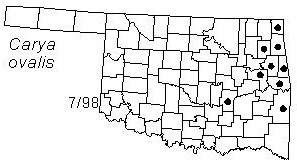Tree to 20 m (65 ft) tall and 30 cm (1 ft) diameter, with irregular spreading crown. Bark light gray and smoothish, becoming fissured into forking ridges on older trunks and branches. Twigs thick, glabrous, reddish-brown. The single terminal bud is large, egg-shaped, with glabrous overlapping scales. Leaves alternate, pinnately compound, 15-25 cm (6-10 in) long, with a slender scurfy-hairy rachis. Leaflets 3-7 (usually 5), lanceolate, 7.5-15 cm (3-6 in) long, acuminate, finely serrate, glabrous yellow-green above, pale green and usually hairy on veins below. Flowers catkins appearing in the early spring. Fruits rounded, 2.5-5 cm (1-2 in) long, with a thin husk.
Distribution: Native to about the eastern 1/3 of the U. S.
Habitat: upland forests.
NWI status: UPL
Comment: The nuts of all the hickories are important food for wildlife, especially squirrels. The seeds of red hickory are thick-shelled, sometimes bitter. Carya is the ancient Greek name for walnut; ovalis refers to the egg-shaped nuts.
Distribution in Oklahoma: 
BACK
NEXT
RETURN TO INDEX
Last update: 9/8/99
 Go to Oklahoma Biological Survey Home Page
Go to Oklahoma Biological Survey Home Page
 Disclaimer
Disclaimer